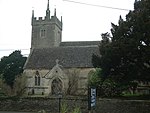Seagry
Civil parishes in WiltshireEngvarB from August 2019OpenDomesdayVillages in Wiltshire

Seagry is a civil parish in Wiltshire, England, about 4.5 miles (7.2 km) southeast of Malmesbury and 5.5 miles (8.9 km) northeast of Chippenham. Its main settlements are the village of Upper Seagry, which was first mentioned in official records under the name Over Seagry (in 1317), and the hamlet of Lower Seagry, which was first documented (1218) as Nether Seagry. The toponym is thought to derive from the Old English for "sedge stream". Sedge is the common name for plants of the family Cyperaceae and stream here may refer to the River Avon, which flows through the area.
Excerpt from the Wikipedia article Seagry (License: CC BY-SA 3.0, Authors, Images).Seagry
Henn Lane,
Geographical coordinates (GPS) Address Phone number Website Nearby Places Show on map
Geographical coordinates (GPS)
| Latitude | Longitude |
|---|---|
| N 51.523 ° | E -2.08 ° |
Address
Seagry Church of England Primary School
Henn Lane
SN15 5EX , Seagry
England, United Kingdom
Open on Google Maps







